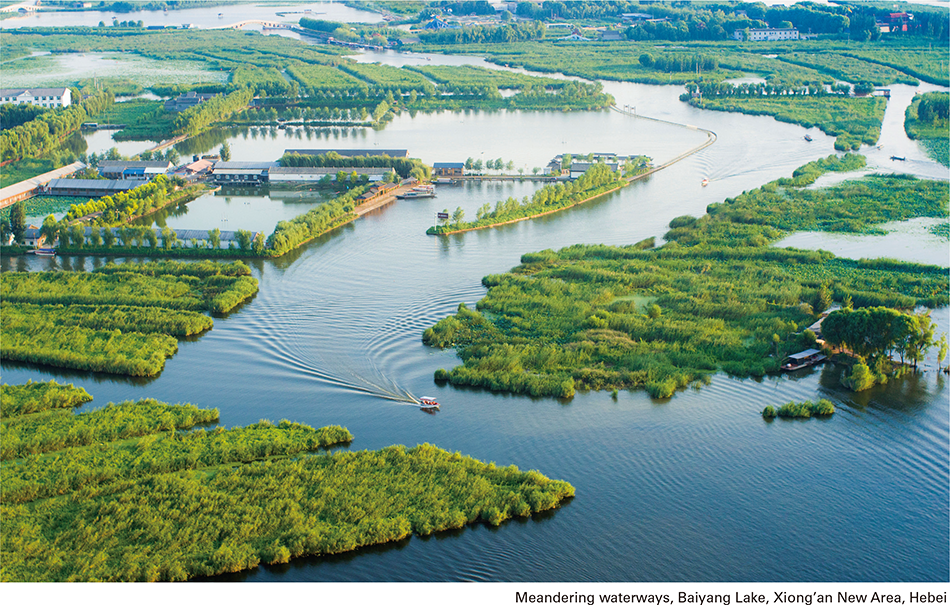COVER STORY:GLOBAL INNOVATION REPORTChina’s City of the Future: Xiong’an New Area
Highlight
As a millennium plan, a project with national significance, the Xiong’an New Area project in China is the first National New Area to be established on a national scale in the 21st century. This article looks over the history of urbanization in China and gives an overview of the plan for Xiong’an New Area and reports on the progress of construction.

Introduction
Figure 1 | Map of Xiong’an New Area and Overview of Development  Located south of Beijing, Xiong’an New Area is undergoing developments that include a startup area and initial area.
Located south of Beijing, Xiong’an New Area is undergoing developments that include a startup area and initial area.
The Central Committee of the Communist Party of China and the State Council announced the decision to establish Xiong’an New Area in Hebei Province on April 1, 2017. The Xiong’an New Area project has the support of President Xi Jinping and other top leaders in China. As a millennium plan, a project with national significance, it is the first National New Area to be established on a national scale in the 21st century, following in the footsteps of the Shenzhen Special Economic Zone and the Pudong New Area in Shanghai. The construction of Xiong’an New Area as a model for undertaking high-quality development throughout China and a new driving force for the modern economic system has great significance in terms of national strategy. This is because Xiong’an New Area, China’s city of the future, seeks to be a leading-edge city that delivers innovative intelligence, a green ecology, and wellbeing (happiness and livability) on the basis of an ultra-long-term plan that runs until 2035. Although people’s values are changing as a result of COVID-19, bringing with it changes in their idea of an ideal city, the plan for Xiong’an New Area is proceeding steadily without major changes, having been informed by the study of a long history based on the wisdom of many of the world’s experts (see Figure 1). After first looking back over the history of urbanization in China, this article gives an overview of the plan for Xiong’an New Area and reports on the progress of construction.
Progress of Urbanization in China and Trends in Urban Development
Figure 2 | Trend in Percentage Urbanization in China and other Major Nations  Urbanization has increased rapidly in China over recent years in response to government policies.
Urbanization has increased rapidly in China over recent years in response to government policies.
Urbanization has advanced rapidly in China along with economic development, with the percentage of the population living in cities rising from 36.22% in 2000 to 60.9% in 2019 (see Figure 2).
The Chinese government adopted an urbanization strategy from 2010, putting work into not only increasing the percentage of people living in cities, but also into the quality of urban development. Under government direction, urbanization in China has made progress on a wide variety of fronts, including better urban living environments, more intelligent cities, health and safety, ease of living, and sustainable development, taking advantage of advances in technology, the growth of emerging businesses, and changes in people’s needs and how they live. Government measures on the construction of model cities are playing leading roles in accelerating the urbanization strategy, such as building low-carbon eco-cities, smart cities, and other model cities across the nation to encourage improvements in city quality (see Table 1).
Urban development in China in the post-pandemic era will see a renewed awareness of the importance of health and safety, including the use of digital technologies to accelerate the construction of smart cities and improvements to public health management in cities. There will be an increased emphasis on quality of life (QoL) considerations such as health, safety, and livability achieved through smarter urban construction, with government investment in new infrastructure strengthening such areas as 5th-generation (5G) telecommunications, artificial intelligence (AI), and data centers. These initiatives will expand beyond major cities like Beijing, Shanghai, and Guangzhou to also include medium-sized and smaller centers, with leading-edge concepts incorporated into new urban developments from the city design stage. The Xiong’an New Area that is attracting international interest is seen in China as a city of the future and a millennium plan, being designed and built on the basis of ideas such as being green, smart, cultural, and creative that reflect trends in future cities and what it is that urban development in China has been seeking to achieve.
Table 1 | Major Model City Initiatives Being Undertaken by Chinese Government  The Chinese government is accumulating construction experience in urbanization by pursuing an urbanization strategy that fosters improvements in city quality through the construction of model cities, including low-carbon eco-cities and smart cities.
The Chinese government is accumulating construction experience in urbanization by pursuing an urbanization strategy that fosters improvements in city quality through the construction of model cities, including low-carbon eco-cities and smart cities.
Objectives of Establishing Xiong’an New Area—City of the Future
At the 19th National Congress of the Chinese Communist Party held in October 2017, President Xi Jinping spoke about the importance of relocating the non-capital functions of Beijing by proceeding with the coordinated development of the Jing-Jin-Ji economic triangle (Beijing, Tianjin, and Hebei), with Xiong’an New Area to serve as a model city established with high standards. Based on this policy, the Leading Group for Coordinated Beijing-Tianjin-Hebei Development as well as the government of Hebei Province have convened the relevant departments/committees and specialist advisory committees from central and national agencies to work jointly on an in-depth investigation of the Xiong’an New Area plan. In April 2018, the Guideline for Planning of Hebei Xiong’an New Area was ratified and released by the Central Committee and State Council, laying out the role to be played by Xiong’an New Area, the missions, objectives and the implementation plans of its planning and construction, as well as other initiatives to complete the development of the city by 2035, along with a future vision to build it into a leading international city in 2050 (see Table 2).
Table 2 | Key Points of Plan for Xiong’an New Area  A long-term master plan that extends to 2035 has been formulated that provides the basic underpinning to guide the planning and construction of Xiong’an New Area, and also envisages a development vision for Xiong’an New Area in the mid-21st century.
A long-term master plan that extends to 2035 has been formulated that provides the basic underpinning to guide the planning and construction of Xiong’an New Area, and also envisages a development vision for Xiong’an New Area in the mid-21st century.
“1+4+26” City Planning System for Xiong’an New Area
To prepare the city plan following the announcement of the master guideline in April 2018, the government of Hebei Province adopted a system that would ensure high-quality planning by inviting more than 1,000 experts from China and abroad, 200 teams, and more than 2,500 engineers and by establishing a number of institutions for planning, evaluation, and verification that included a working group for New Area planning, a planning consultation experts group, national-level advisory and verification institutions, and a provincial government experts committee (see Table 3). The “1+4+26” system is a series plan that is made up of a single master guideline (Guideline for Planning of Hebei Xiong’an New Area), four regional and sectorial overall plans, and 26 specialized plans for aspects such as flood prevention, disaster response, energy, and integrated transportation.
The four regional and sectorial overall plans include staged plans for spatial design and work on construction of the Xiong’an New Area. Xiong’an New Area is made up of three Hebei Province counties, Xiong, Rongcheng, and Anxin, as well as some surrounding areas and is located about 105 km from both Beijing and Tianjin. The development covers 1,770 km2 in total and was planned on the concept of “one center, five auxiliaries, multiple nodes.” The “center” is the 198 km2 startup area of Xiong’an that will form its city proper. The five auxiliaries are Xiong county, Rongcheng county, Anxin county, Zhaili Village, and Zangang Town, which are located outside the startup area. The “multiple nodes” refer to the many distinctive small towns and scenic villages in the region. The startup area also includes a 38-km2 initial area where construction will start first and that will serve as an innovation model area for the city (see Figure 1).
Table 3 | Overview of City Construction Planning for Xiong’an New Area  The “1+4+26” structure for planning has established a sound basis for large-scale construction in the Xiong’an New Area.
The “1+4+26” structure for planning has established a sound basis for large-scale construction in the Xiong’an New Area.
Principles and Features in Future City Planning
The city plan for Xiong’an New Area as a leading-edge future city reflects the principles of innovative intelligence, green ecology, and wellbeing, as manifested in the 1+4+26 plans. The master guideline specifies 38 specific goals to be achieved by 2035 (nine for innovative intelligence, 17 for green ecology, and 12 for wellbeing), with plans also being established for goal actualization and for the route by which they are to be realized.
• Innovation city
The mission of Xiong’an New Area as an innovation city is to achieve the synergistic development of a leading international region for science and technology, innovative industries, research and development, modern finance, and human resources. Accordingly, the relocation of the non-capital functions of Beijing to Xiong’an New Area is to be undertaken primarily by relevant institutions, most of which are from the following six fields.
- Scientific research institutions including major universities, laboratories of national importance, and innovation centers of national importance
- Healthcare institutions including top-class hospital and leading medical research institutions
- Financial institutions including financial business headquarters
- Software, telecommunications, design, consulting, logistics, electronic commerce, and other corporate headquarters in advanced service businesses
- Central, private, and technology companies in advanced technology industries engaged in next-generation information technology, biomedicine, biohealth, energy-efficient environment, and the research and development of advanced materials
- Zhongguancun Science Park of Xiong’an New Area
These institutions and companies will play the main role in building the city into an innovation hub, through measures to facilitate the establishment of state-owned and private companies and the startup of venture businesses in emerging sectors, as well as measures for the recruitment and training of talent.
• Intelligent city
Figure 3 | Overview of Work on Xiong’an New Area Intelligent City  The intelligent city will proceed on the basis of four PFs and five scenarios.
The intelligent city will proceed on the basis of four PFs and five scenarios.
The objective of constructing an intelligent city in Xiong’an New Area is to realize the synchronized planning and construction of both a physical city and a digital city, supported by infrastructure that is appropriate to a new style of intelligent city and traditional urban infrastructure. Infrastructure appropriate to a new style of intelligent city in Xiong’an New Area mainly refers to next-generation infrastructure such as city-wide intelligent sensing systems [the Internet of Things (IoT)], next-generation telecommunication networks (5G), urban cloud and big data platforms (PFs), urban computing capacity, and city brains (AI) (see Figure 3). Because there is no precedent anywhere in the world that can serve as a model for the construction of an intelligent city from scratch, Xiong’an New Area has undertaken pioneering exploratory and practical measures in a variety of areas based on experience of the construction of other smart cities drawn extensively from China and elsewhere. In particular, this has involved joint research into intelligent city construction standards in partnership with major universities, scientific research and design institutions, and construction companies in sectors such as information, construction, transportation, and finance, with Xiong’an New Area officially publishing the first edition of the standards regime for intelligent city construction in Xiong’an New Area in May 2020, including the issuing of an initial tranche of eight standards on such topics as IoT device construction (roads) and 5G telecommunication construction guidelines. The intelligent city construction standards are split into three categories (the construction of infrastructure and sensing systems, intelligent applications, and information security), with plans for around 100 specific standards that encompass nine aspects of the intelligent city standards system. In the case of intelligent applications, the intention is to develop this in a way that is open to the rest of the world and involves collaborative creation on the introduction of advanced technology.
• Green city
In the context of ecological civilization development, the establishment of the Xiong’an New Area has an important mission in terms of transforming and advancing urbanization in China. One of the aims of new area construction is to establish a pattern of urban spaces that interweave the blue (wetlands) and green (forests, farmland, and grass) to integrate water and city by prioritizing the ecological environment and being rigorous about green development. The aim is to achieve green performance indicators by 2035 that include a percentage of blue and green spaces of more than 70%, 40% forest coverage, and to have 100% availability of public space facility services within 300 meters in the startup area. Along with an ecological environment, the creation of an intelligent transportation system and intelligent city will rigorously adhere to the principles of green ecological development. To achieve green urban development, the city is putting green foundations in place through the comprehensive adoption of water-saving social construction, sponge city construction, popularization of green buildings, use of green construction materials, separation of stormwater and wastewater, cyclic wastewater and waste processing and recycling, supply of electric power generated by renewable energy, and construction of diverse and clean heating systems.
• Livable city
Reflecting people-centric concepts, the plan for Xiong’an New Area is establishing a hierarchical community service structure by building three levels of public service centers (community, district, and neighborhood) to provide residents with appropriate cultural education, medical care, social security, and social welfare services. The initial area community, for example, is planning six 15-minute living zones made up of 15-minute zones with a service radius of about 1 km, a coverage area of about 3 km2, and servicing a population of approximately 50,000, providing facilities such as a hub for transferring between public transportation services, middle school, health service center, cultural activity center, community service center, public fitness center, and elderly care center (see Table 4).
The transportation system is designed for convenience. It will include a comfortable railway network linking the main cities in the vicinity, public transportation hubs within 300 m in the startup area, and 100% public transportation service coverage of city roads. This will create an environment in which people can live comfortable and relaxed lives by building walking and cycling greenways that connect the green spaces, parks, and single-purpose roads in the cities, city clusters, and community areas to ensure a green mobility mode of public transport + bicycles + walking.
Table 4 | Structuring of Public Services in Xiong’an New Area  Public activity spaces and public services are arranged hierarchically to create a rational urban living environment.
Public activity spaces and public services are arranged hierarchically to create a rational urban living environment.
Progress of Xiong’an New Area Construction
Figure 4 | Site of Xiong’an Citizen Service Center Before and After Construction  The photographs show the site of the Xiong’an Citizen Service Center before and after construction. Construction commenced on December 7, 2017 and was completed just 112 days later. The total construction area of 99,600 m2 is made up of four areas: a public service area, administrative service area, lifestyle service area, and corporate tenant office area.
The photographs show the site of the Xiong’an Citizen Service Center before and after construction. Construction commenced on December 7, 2017 and was completed just 112 days later. The total construction area of 99,600 m2 is made up of four areas: a public service area, administrative service area, lifestyle service area, and corporate tenant office area.
Construction of the new area has been progressing gradually in parallel with preparation of the various plans since the establishment of Xiong’an New Area was decided in April 2017. Along with work on the ecological environment around Xiong’an New Area since November 2017, the Xiong’an Citizen Service Center has also commenced. The center is the first large urban construction project for Xiong’an, which commenced operation in June 2018 for providing public and living services to residents, as well as to serve as a demonstration space where people can experience the future city for themselves (see Figure 4).
Under the principle of prioritizing the ecological environment, the Qiannian Xiulin, or Millennium Forest afforestation project and water quality and ecological conservation activities in the Baiyang Lake catchment have proceeded in advance of infrastructure construction. The total area planted with forest by the Millennium Forest project had reached more than 20,000 h (200 km2) by the end of 2019, increasing forest coverage from 11% to 22.7%. Through measures that have included cleaning up waste in waterways and controlling the release of pollution by companies, water quality in the Baiyang Lake central area has improved from below class V to class IV, and the quality of surface water in the test area has improved to class III. Meanwhile, to help become a low-carbon, resource recycling city, Xiong’an is ahead of the rest of China in implementing the “coal to electricity” and “coal to gas” transition whereby clean energy sources such as electricity and natural gas are used instead of coal for home heating.
As the most important foundation for urban development, Xiong’an is building railways, expressways, and internal road networks to establish intercity and regional links. An intercity railway line linking Beijing Daxing International Airport and Xiong’an railway station commenced operation in September 2019 in the Beijing region (from Beijing West Railway Station to Beijing Daxing International Airport), and work was completed on the main structure of Xiong’an railway station in April 2020 (see Figure 5). Meanwhile, the main road building and paving work for the Jingxiong Expressway linking Xiong’an to the outside world and the region’s Rongyi highway network (between Rongcheng County and Yi County) are proceeding on schedule.
In accordance with the construction plan, Xiong’an New Area commenced its smart city construction from 2020. Through the simultaneous installation of traditional urban infrastructure and digital infrastructure, large-scale and substantive construction has started in earnest aimed at building a digital twin city that fuses the physical world and virtual space. Digital infrastructure is proceeding on the basis of a framework centered on “one center and four platforms.” “One center and four platforms” refers to the urban computing center (cloud), block data platform, IoT integrated open platform, video network platform, and construction information modeling (CIM) platform. For the intelligent applications that run on the platforms, which include facilities management, transportation, distribution, and energy, the Xiong’an Public Service Center is exploring scenarios for the future in the model area. This is intended to create a model for future cities, with a number of projects getting underway at the center’s site, including smart lighting poles equipped with 5G telecommunications and road-vehicle integration functions, the building of a model area for use of 5G, and a vehicle-to-X (V2X) (model for coordination of vehicles and roads) project that can be scaled to various scenarios.
Following the outbreak of the COVID-19 pandemic in January 2020, Xiong’an New Area adopted an unequivocal stance of an early resumption of construction. Construction had recommenced at approximately 50% of major projects by February 24 and a 100% return to work was achieved by the end of April. The first and second central budgets for May and July of the National Development and Reform Commission specified investment of CNY3.5 billion (approximately JPY53.5 billion) for Xiong’an, including plans to accelerate work on upgrades to sewage and waste processing facilities to improve sanitation; the undergrounding of water, sewage, and gas networks; and the construction of railways and associated facilities.
Figure 5 | Completed Construction of Xiong’an Railway Station Main Structure  Photograph by Sun Lijun, People's Daily
Photograph by Sun Lijun, People's Daily
The installation of unfaced concrete for the Xiong’an Railway Station was largely completed on July 13, 2020, with work on the rain canopy roof and upper floor steelwork proceeding well.
Conclusions
Setting the concept design, goals, and plans as a millennium plan, Xiong’an New Area is making steady progress. The city development concept reflects the dream of Chinese urban construction that looks to the future and it will inevitably have a major impact on the progress of urbanization in China. The May 2020 session of the 13th National People’s Congress announced strategies for the ongoing development of the Chinese economy in FY2020 and beyond that included measures such as boosting internal demand post-pandemic, strengthening innovation to achieve economic growth, new infrastructure investment, and new urbanization. Urbanization and regional development will be significantly encouraged by the implementation of the various measures and this will serve as a driver for future economic growth in China. In terms of the key focus for urban development, along with digitalization and greening, an emphasis will also be placed on the establishment of a public health system and ensuring the health and safety of city residents as important priorities.
During the construction of Xiong’an New Area, the world’s advanced technologies have been introduced to build new open platforms. As construction progresses, opportunities for global corporations to become involved will increase. On the other hand, the progress of urbanization in China requires that regional development proceed through coordination between major cities and small and medium-sized cities, involving not only the creation of new cities, as is the case with Xiong’an New Area, but also the upgrading of existing cities, and this gives rise to major business opportunities. Hitachi intends to take advantage of these opportunities and contribute to improving people’s QoL in China through its businesses that deal with urban construction, in Xiong’an New Area and elsewhere.
REFERENCES
- 1)
- People’s Press Editorial Committee, “Guideline for Planning of Hebei Xiong’an New Area,” People’s Press (Sept. 2018) in Chinese.
- 2)
- Central Committee of the Communist Party of China, State Council, “Guidelines of the Central Committee of the Communist Party of China and the State Council on Supporting the Comprehensive Deepening of Reform and Expansion of Opening Up in the Hebei Xiong’an New Area,” People’s Press (Jan. 2019) in Chinese.
- 3)
- Specialist Committee for Coordinated Beijing-Tianjin-Hebei Development, Central Ministries and Commissions, Hebei Province, “Controllability Detailed Plan for Initial Area, Xiong’an New Area, Hebei Province/Controllability Plan for Startup Area, Xiong’an New Area, Hebei Province” (Jan. 2020) in Chinese.
- 4)
- Xiong’an Green Development Research Institute, “Xiong’an New Area Green Development Report (2017-2019) – A Green Beginning of the New City,” China City Press (Mar. 2020) in Chinese.
- 5)
- Xiong’an New Area in Chinese
- 6)
- Chinese government
- 7)
- Xiongan Online
- 8)
- China News Service






